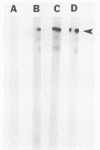Abstract
No protective antigens from Entamoeba histolytica have been previously defined. We tested the ability of the galactose-specific adherence lectin of E. histolytica to elicit a protective immune response in conjunction with Freund's incomplete and complete adjuvants. The gerbil (Meriones unguiculatus) model of an experimental amebic liver abscess was used. Gerbils were immunized intraperitoneally or subcutaneously with 10 micrograms of the affinity-purified lectin in complete Freund's adjuvant and then at 2 and 4 weeks with 10 micrograms of the lectin in incomplete Freund's adjuvant. All of the immunized animals developed antilectin antibody titers of greater than 1/1,024 as measured by a radioimmunoassay. The gerbil antilectin antibodies were shown by Western immunoblotting to be directed to the heavy subunit but not the light subunit of the lectin. Immune gerbil sera inhibited amebic adherence by 100% at a 1/10 dilution. Immune and control gerbils were challenged at 6 weeks by the intrahepatic injection of 5 x 10(5) E. histolytica trophozoites. Four independent trials demonstrated complete protection from amebic liver abscess formation in 67% of lectin-immunized gerbils. Unexpectedly, liver abscess weights were significantly higher in the gerbils that failed to become immune than in the control animals. Our results demonstrate that the galactose lectin is a protective antigen and provide an immune-animal model to study the mechanisms of protection and potential disease exacerbation conferred by the antilectin immune response.
Full text
PDF
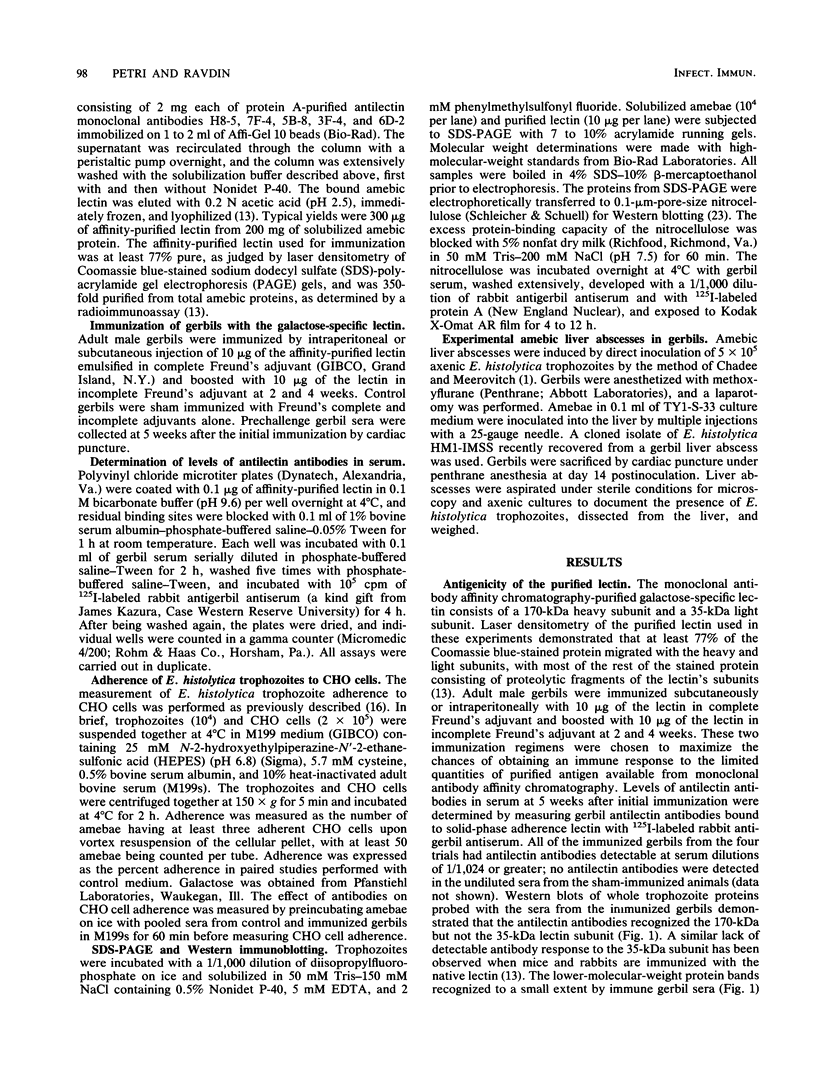
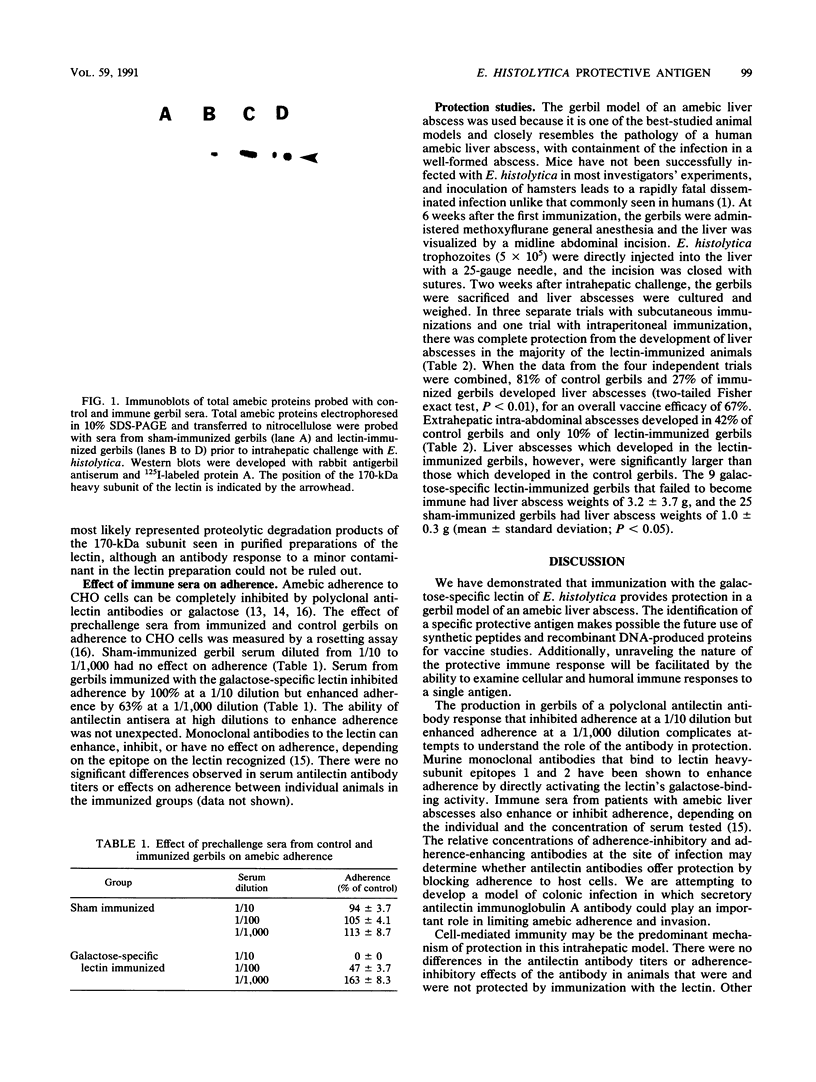
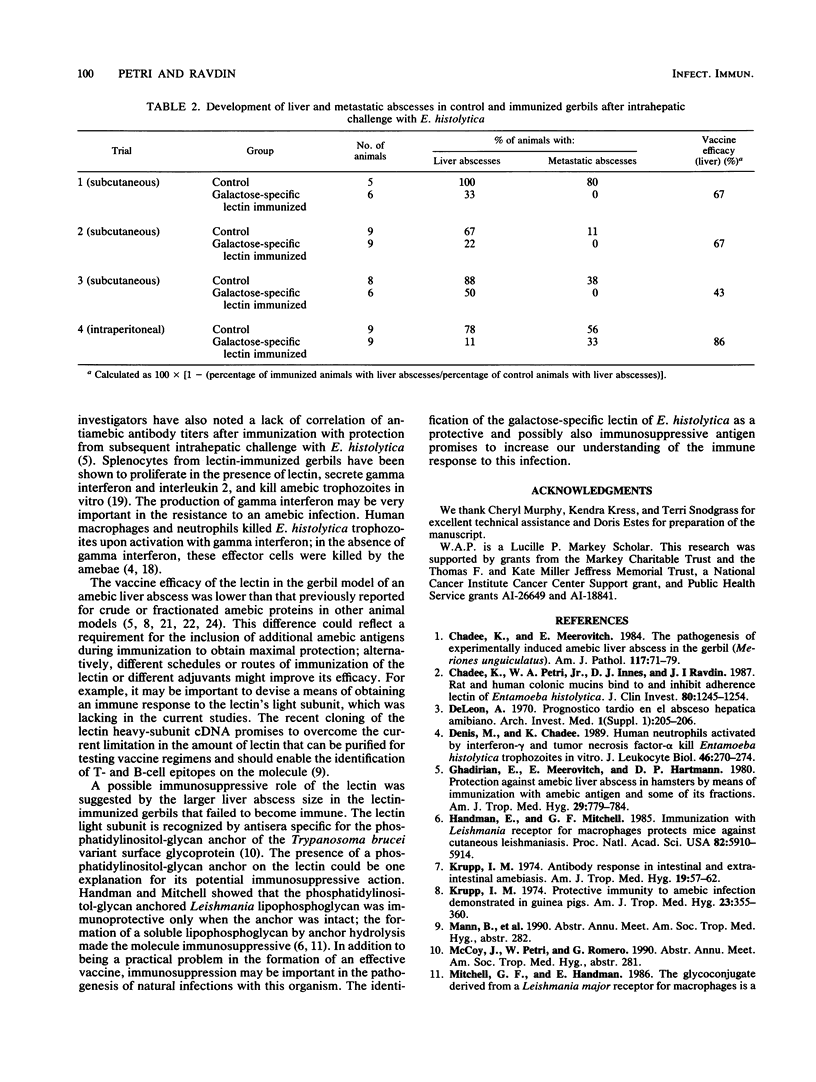
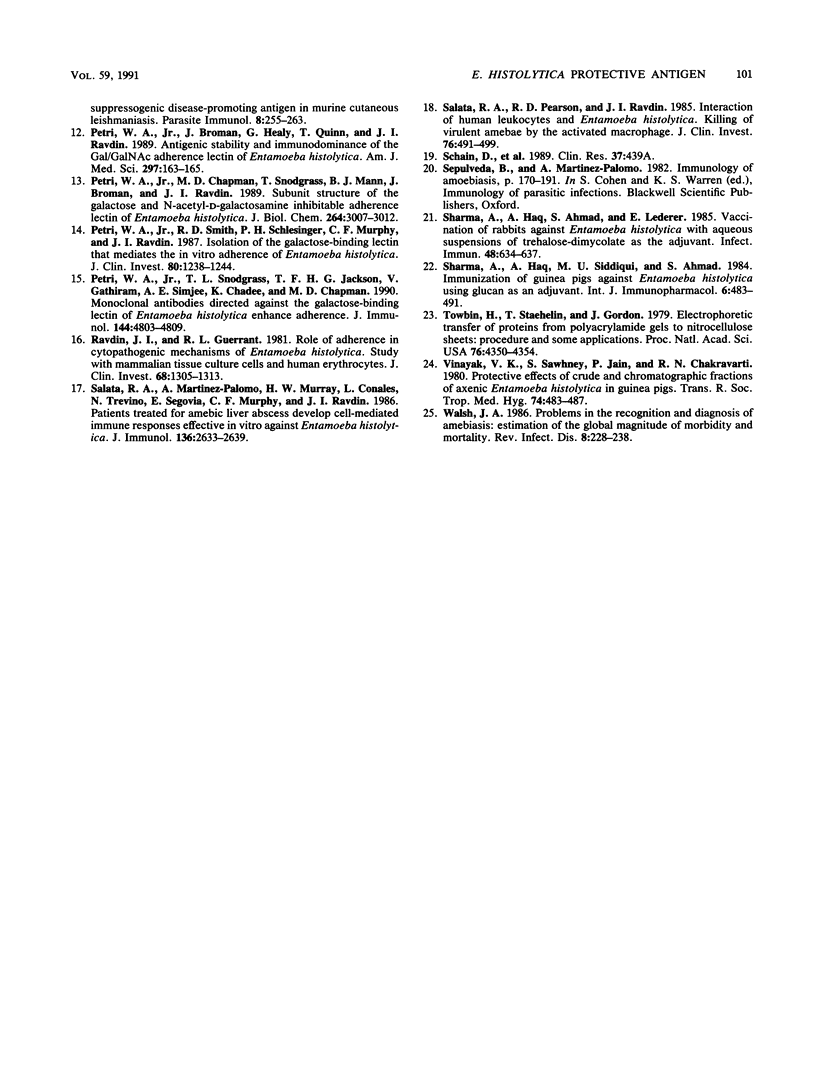
Images in this article
Selected References
These references are in PubMed. This may not be the complete list of references from this article.
- Chadee K., Meerovitch E. The pathogenesis of experimentally induced amebic liver abscess in the gerbil (Meriones unguiculatus). Am J Pathol. 1984 Oct;117(1):71–80. [PMC free article] [PubMed] [Google Scholar]
- Chadee K., Petri W. A., Jr, Innes D. J., Ravdin J. I. Rat and human colonic mucins bind to and inhibit adherence lectin of Entamoeba histolytica. J Clin Invest. 1987 Nov;80(5):1245–1254. doi: 10.1172/JCI113199. [DOI] [PMC free article] [PubMed] [Google Scholar]
- Denis M., Chadee K. Human neutrophils activated by interferon-gamma and tumour necrosis factor-alpha kill Entamoeba histolytica trophozoites in vitro. J Leukoc Biol. 1989 Sep;46(3):270–274. doi: 10.1002/jlb.46.3.270. [DOI] [PubMed] [Google Scholar]
- Ghadirian E., Meerovitch E., Hartmann D. P. Protection against amebic liver abscess in hamsters by means of immunization with amebic antigen and some of its fractions. Am J Trop Med Hyg. 1980 Sep;29(5):779–784. doi: 10.4269/ajtmh.1980.29.779. [DOI] [PubMed] [Google Scholar]
- Handman E., Mitchell G. F. Immunization with Leishmania receptor for macrophages protects mice against cutaneous leishmaniasis. Proc Natl Acad Sci U S A. 1985 Sep;82(17):5910–5914. doi: 10.1073/pnas.82.17.5910. [DOI] [PMC free article] [PubMed] [Google Scholar]
- Krupp I. M. Antibody response in intestinal and extraintestinal amebiasis. Am J Trop Med Hyg. 1970 Jan;19(1):57–62. doi: 10.4269/ajtmh.1970.19.57. [DOI] [PubMed] [Google Scholar]
- Krupp I. M. Protective immunity to amebic infection demonstrated in guinea pigs. Am J Trop Med Hyg. 1974 May;23(3):355–360. doi: 10.4269/ajtmh.1974.23.355. [DOI] [PubMed] [Google Scholar]
- Mitchell G. F., Handman E. The glycoconjugate derived from a Leishmania major receptor for macrophages is a suppressogenic, disease-promoting antigen in murine cutaneous leishmaniasis. Parasite Immunol. 1986 May;8(3):255–263. doi: 10.1111/j.1365-3024.1986.tb01037.x. [DOI] [PubMed] [Google Scholar]
- Petri W. A., Jr, Broman J., Healy G., Quinn T., Ravdin J. I. Antigenic stability and immunodominance of the Gal/GalNAc adherence lectin of Entamoeba histolytica. Am J Med Sci. 1989 Mar;297(3):163–165. doi: 10.1097/00000441-198903000-00006. [DOI] [PubMed] [Google Scholar]
- Petri W. A., Jr, Chapman M. D., Snodgrass T., Mann B. J., Broman J., Ravdin J. I. Subunit structure of the galactose and N-acetyl-D-galactosamine-inhibitable adherence lectin of Entamoeba histolytica. J Biol Chem. 1989 Feb 15;264(5):3007–3012. [PubMed] [Google Scholar]
- Petri W. A., Jr, Smith R. D., Schlesinger P. H., Murphy C. F., Ravdin J. I. Isolation of the galactose-binding lectin that mediates the in vitro adherence of Entamoeba histolytica. J Clin Invest. 1987 Nov;80(5):1238–1244. doi: 10.1172/JCI113198. [DOI] [PMC free article] [PubMed] [Google Scholar]
- Petri W. A., Jr, Snodgrass T. L., Jackson T. F., Gathiram V., Simjee A. E., Chadee K., Chapman M. D. Monoclonal antibodies directed against the galactose-binding lectin of Entamoeba histolytica enhance adherence. J Immunol. 1990 Jun 15;144(12):4803–4809. [PubMed] [Google Scholar]
- Ravdin J. I., Guerrant R. L. Role of adherence in cytopathogenic mechanisms of Entamoeba histolytica. Study with mammalian tissue culture cells and human erythrocytes. J Clin Invest. 1981 Nov;68(5):1305–1313. doi: 10.1172/JCI110377. [DOI] [PMC free article] [PubMed] [Google Scholar]
- Salata R. A., Martinez-Palomo A., Murray H. W., Conales L., Trevino N., Segovia E., Murphy C. F., Ravdin J. I. Patients treated for amebic liver abscess develop cell-mediated immune responses effective in vitro against Entamoeba histolytica. J Immunol. 1986 Apr 1;136(7):2633–2639. [PubMed] [Google Scholar]
- Salata R. A., Pearson R. D., Ravdin J. I. Interaction of human leukocytes and Entamoeba histolytica. Killing of virulent amebae by the activated macrophage. J Clin Invest. 1985 Aug;76(2):491–499. doi: 10.1172/JCI111998. [DOI] [PMC free article] [PubMed] [Google Scholar]
- Sharma A., Haq A. U., Siddiqui M. U., Ahmad S. Immunization of guinea pigs against Entamoeba histolytica using glucan as an adjuvant. Int J Immunopharmacol. 1984;6(5):483–491. doi: 10.1016/0192-0561(84)90087-0. [DOI] [PubMed] [Google Scholar]
- Sharma A., Haq A., Ahmad S., Lederer E. Vaccination of rabbits against Entamoeba histolytica with aqueous suspensions of trehalose-dimycolate as the adjuvant. Infect Immun. 1985 Jun;48(3):634–637. doi: 10.1128/iai.48.3.634-637.1985. [DOI] [PMC free article] [PubMed] [Google Scholar]
- Towbin H., Staehelin T., Gordon J. Electrophoretic transfer of proteins from polyacrylamide gels to nitrocellulose sheets: procedure and some applications. Proc Natl Acad Sci U S A. 1979 Sep;76(9):4350–4354. doi: 10.1073/pnas.76.9.4350. [DOI] [PMC free article] [PubMed] [Google Scholar]
- Vinayak V. K., Sawhney S., Jain P., Chakravarti R. N. Protective effects of crude and chromatographic fractions of axenic Entamoeba histolytica in guinea-pigs. Trans R Soc Trop Med Hyg. 1980;74(4):483–487. doi: 10.1016/0035-9203(80)90063-2. [DOI] [PubMed] [Google Scholar]
- Walsh J. A. Problems in recognition and diagnosis of amebiasis: estimation of the global magnitude of morbidity and mortality. Rev Infect Dis. 1986 Mar-Apr;8(2):228–238. doi: 10.1093/clinids/8.2.228. [DOI] [PubMed] [Google Scholar]



